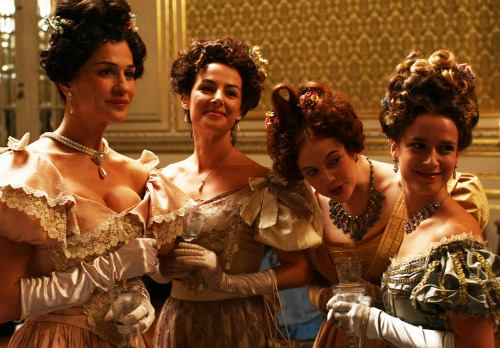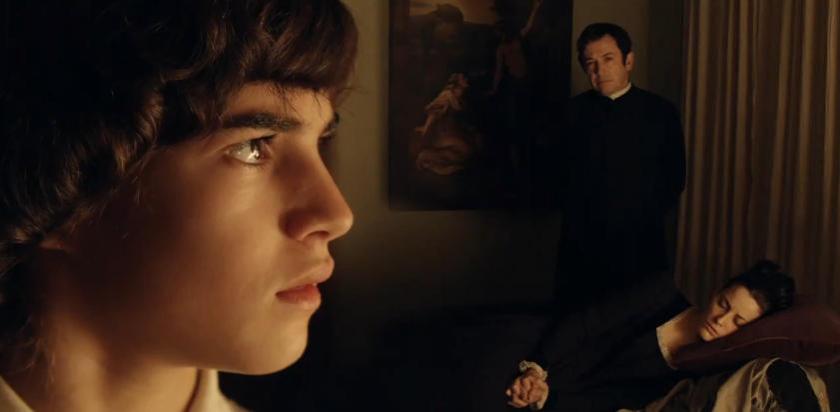“This story is not my child, or my godchild. It is not a work of fiction. It is a diary of suffering,” a title says at the beginning of Raúl Ruiz’s magnificent Mysteries of Lisbon. A sombrely beautiful 19th-century costume drama spanning decades and continents and featuring tortured lovers, deathbed confessors, abandoned sons, femmes fatales, sniping aristocrats, Napoleonic-era firing squads and duellists, Ruiz’s labyrinthine, flashback-laden movie makes for a peculiarly heady blend of Romantic epic-cum-soap-opera and Modernist disquisition on narrative self-reflexivity. And it is, to these eyes, the most exquisitely intense film of 2011, though an air of ironic detachment keeps it from overheating.
Shown in six one-hour parts on European television and whittled down to four hours 26 minutes for theatrical release (the cut Ruiz preferred), it is based on the eponymous three-volume 1854 novel by the Portuguese writer Camilo Castelo Branco, who wrote a hundred-odd volumes incorporating 260 works before shooting himself, a blind, syphilitic viscount, at the age of 65 in 1890 (his Doomed Love was filmed as a miniseries by Manoel de Oliveira in 1979). At once Balzacian and Dickensian, and influenced, too, by Victor Hugo, the film at one point wanders off into 18th-century Gothic in a passage depicting amour fou that’s announced by a reference to the novelist Ann Radcliffe. Before he died at age 70 in August, Ruiz worked on three more films. Mysteries of Lisbon, though, is likely to remain the epitaph of a master who reached earlier peaks with his cryptic classics Three Crowns of the Sailor (1982), City of Pirates (1983) and Treasure Island (1985), and another with his adaptation of Proust’s Time Regained (1999).
Why do parents lose their children? Why does romantic love fail and maim? Why is happiness short-lived?
Any attempt to encapsulate the plot of Mysteries of Lisbon is a fool’s errand, and we will offer the barest bones here. Stories breed interlocking stories in this pantechnicon, which begins at the time of the Portuguese Liberal wars in the early 1830s. Although the nominal protagonist is João (João Luís Arrais), a solemn 14-year-old foundling at a college watched over by a kindly, all-knowing priest, Father Dinis (Adriano Luz), at times he disappears from the saga for so long you wonder if he’s ever going to return.
Early on João falls into a dream - all wavering distortion - and senses the presence of his long-lost mother, Angela (Maria João Bastos), who has been locked away by her philandering husband, the Count of Santa Bárbara. The boy’s impecunious father, whom she deeply loved, had been murdered by a drunken cut-throat hired by the pregnant Angela’s wealthy father. A gypsy horse trader bought Angela’s baby from the cut-throat, who used the money to start a fortune based on piracy and slavery, and who rematerialises as the Brazilian nouveau riche Alberto de Magalhães (Ricardo Pereira), a Byronic salon predator. Alberto, we eventually learn, spurned the infatuated society adventuress Elisa de Montfort (Clotilde Hesme, pictured below) after paying her a fortune for a night of sex. Like Dinis, though, he is protective of the boy, whose birth delivered him from evil.
 The gypsy is none other than the shapeshifting Father Dinis, who, attending the contrite Count of Santa Bárbara’s deathbed, meets the elderly Friar Baltasar. The monk recognises him as his son and later summons him to explain how, as a young rake, he fell in love and absconded with the married Countess Silvina, who died in childbirth in Venice, prompting him to renounce earthly pleasures. A child at the time of the French Revolution, Dinis grew up as Sebastião de Melo in the De Montfort family, and as a young soldier fell in love with Blanche de Clermont, who, though enamoured of another officer, married Sebastião’s stepbrother Benoit and bore twins, Elisa and Arthur. When the grown-up João meets Elisa she encourages him to fall in love with her so that he will duel with Alberto, whom she hates for rejecting her…
The gypsy is none other than the shapeshifting Father Dinis, who, attending the contrite Count of Santa Bárbara’s deathbed, meets the elderly Friar Baltasar. The monk recognises him as his son and later summons him to explain how, as a young rake, he fell in love and absconded with the married Countess Silvina, who died in childbirth in Venice, prompting him to renounce earthly pleasures. A child at the time of the French Revolution, Dinis grew up as Sebastião de Melo in the De Montfort family, and as a young soldier fell in love with Blanche de Clermont, who, though enamoured of another officer, married Sebastião’s stepbrother Benoit and bore twins, Elisa and Arthur. When the grown-up João meets Elisa she encourages him to fall in love with her so that he will duel with Alberto, whom she hates for rejecting her…
When it comes to who did what to whom and why, the film’s many mysteries are solved, but the bigger existential questions - why do parents lose their children? Why does romantic love fail and maim? Why is happiness short-lived? Why can’t sons and daughters escape the sins of their fathers? - remain unanswered. An air of fatalism hangs over everyone’s lives and João’s existence in particular. Representing the polarities of paternal favour, the omniscient, God-like Dinis and the honorable rogue Alberto can only help João so far, but like post-Napoleonic Europe, of which, as a youth, he is a disinherited Everyman, he exists in a state of flux. It is little wonder that, at the end of the film, he appears to return to the fever dream in which he slipped after being beaten by a school bully in the opening minutes. Such is Ruiz’s approach to his self-consciously narrated life, one wonders if the convoluted events that have produced him - a rootless wanderer of the seas, seemingly doomed to die in his twenties - have occurred at all or whether they comprise a tale (which, of course, they do).
 Digitally shot, almost entirely in muted chiaroscuro, by Andre Szankowski, Mysteries of Lisbon unfolds in a permanently overcast Europe. Even the interior scenes in private quarters and opulently dressed Visconti-ish ballrooms and drawing rooms, where the upper classes (pictured left) gather to mock and humiliate each other, are devoid of vibrant colour, as if painted by Rembrandt. The camera moves silkily and constantly, spiralling around the grouped characters in an Ophülsian manner, drawing attention to the artifice and the sense that the film has been directed, as the original novel was written.
Digitally shot, almost entirely in muted chiaroscuro, by Andre Szankowski, Mysteries of Lisbon unfolds in a permanently overcast Europe. Even the interior scenes in private quarters and opulently dressed Visconti-ish ballrooms and drawing rooms, where the upper classes (pictured left) gather to mock and humiliate each other, are devoid of vibrant colour, as if painted by Rembrandt. The camera moves silkily and constantly, spiralling around the grouped characters in an Ophülsian manner, drawing attention to the artifice and the sense that the film has been directed, as the original novel was written.
The opening credits appear over ornamental tiles depicting incidents we will see, as do the shots of João’s children’s theatre, which he carries with him through life. He even has a “Rosebud”: a framed pencil drawing of himself done by his mother that he hangs on the wall when he falls ill toward the end. Elsewhere, Ruiz breaks the naturalistic spell with Surrealist and absurdist touches redolent of his earlier work - one character shoots himself dead and then appears fully alive, if mortified, moments later. A cup reflects faces in the coffee it contains and then hovers in space. Alberto’s butler skitters spastically over the floor and jumps out of nowhere to crash into his master. Why would he do that when Alberto beats him? Where do the games in Mysteries of Lisbon begin and end?
They don’t necessarily end at all. Ruiz suggests that as people’s stories overlap, everybody’s life (and everybody’s subjectivity) is embraced in the tragic human comedy. It’s no surprise that a Ruizian man of God, Father Dinis, should be the benevolent puppetmaster who pulls the strings and offers his wisdom, but who can’t save people from themselves or their birthrights.
Watch the trailer to Mysteries of Lisbon














Add comment